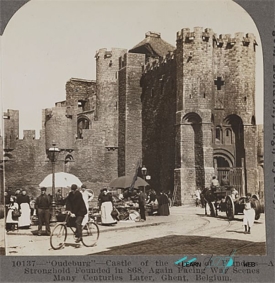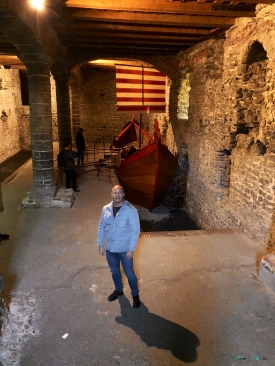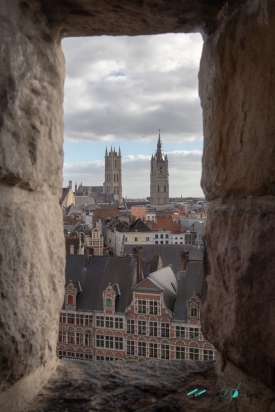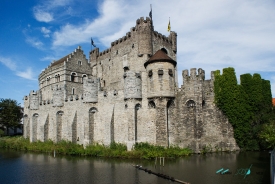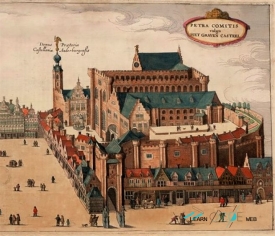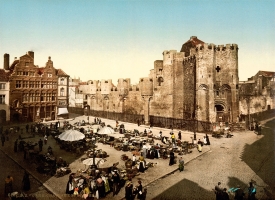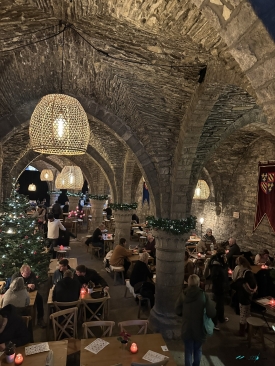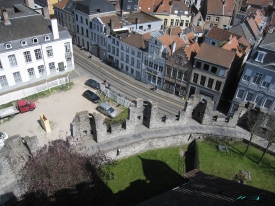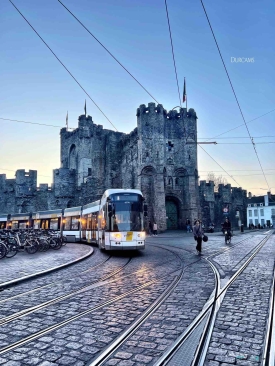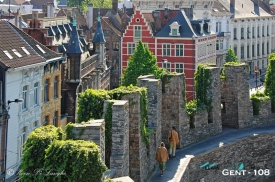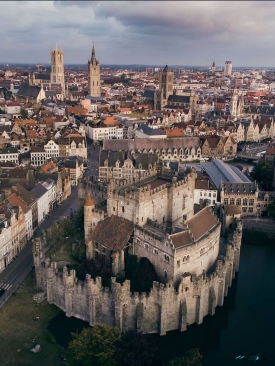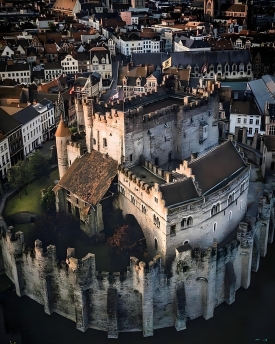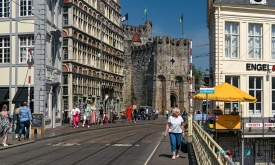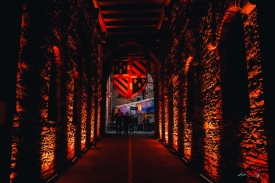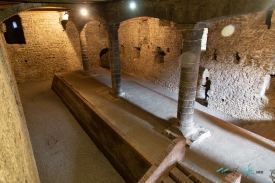Nestled in the heart of the charming city of Ghent, Belgium, Gravensteen Castle stands as a testament to centuries of history and architectural prowess. This fortified moated castle, with its remarkably preserved defense system, has witnessed the ebb and flow of time since its inception in 1180.
Origins and Evolution
Gravensteen's story begins in the 9th century when Count Baldwin I erected a defensive structure to ward off the marauding Norsemen. Over the years, the castle underwent several transformations, with Count Arnulf I in the 10th century introducing significant changes, marking the transition from a wooden fortification to a more substantial precursor of the later castle.
In the 11th century, under the rule of Count Robert I the Frisian, the castle underwent a radical overhaul. The central wooden structure gave way to a grand stone keep measuring 33 by 18.8 meters, featuring three floors adorned with monumental halls, stone staircases, and innovative amenities of the time. This era reflected opulence and comfort, with the large hall serving a representative function while the count's actual living quarters likely resided nearby.
The Motte-and-Bailey Phase
During subsequent construction phases, a motte-and-bailey castle emerged, characterized by an upper and lower ward. The stone keep became the focal point atop a motte mound, formed by earth from the surrounding moat. The lower hall, originally on the ground floor, transformed into a cellar. The motte plateau housed various wooden structures, while a stone gate and enclosure separated the upper ward from a lower ward containing utility buildings. Motte-and-bailey castles were prevalent in the 11th and 12th centuries, serving as symbols of nobility's presence in specific regions.
Renaissance under Count Philip of Alsace
In 1180, Count Philip of Alsace initiated the construction of a new fortress on the existing castle grounds. The motte was heightened, serving as the base for a series of wooden structures. The central hall structure evolved into a majestic donjon or Hall Keep, towering around 30 meters. The gate received an extension, connecting to an enclosure with 24 protruding towers. The diverse hues of stones used in construction added a rich aesthetic to the military architecture. This revamped Gravensteen stood as an unmistakable symbol of feudal power in the lively city of Ghent, countering the towering stone houses of the affluent patricians across the Leie River.
Changing Fortunes and Renewed Purpose
The castle retained its administrative function until the 15th century when Count Louis of Male found Gravensteen lacking in comfort, relocating the residential function to Hof ten Walle. However, the castle continued its broader governance role in the County of Flanders. In 1353, the Mint of Ghent moved to the castle, followed by the Council of Flanders in 1407. The castle also served as a prison over the years.
As the centuries passed, the castle's moats along Sint-Veerleplein and Geldmunt gradually filled up, leading to the construction of houses that largely obscured Gravensteen from view until around 1900.
From Neglect to Restoration
The Council continued to use the castle until 1778, after which private individuals acquired sections of Gravensteen. Jean-Denis Brismaille, in 1807, transformed the upper ward into an industrial complex, housing a cotton spinning mill in the donjon and providing accommodation for fifty working-class families in other buildings. This conversion reflected the early industrial developments in Ghent.
The late 19th century witnessed a reevaluation of Gravensteen's significance. The city and state repurchased the complex, unveiling the medieval ruins during dismantling works. A major restoration, starting in 1894 under the guidance of architect Joseph de Waele, aimed to restore the castle to its perceived medieval glory. While some details incorporated during this restoration may not authentically reflect medieval architecture, the process brought Gravensteen global acclaim, solidifying its status as Ghent's most visited tourist monument.
Gravensteen in the Modern Era
Despite remaining one of Ghent's most visited landmarks throughout the 20th century, Gravensteen faced challenges in terms of conservation and stability. Scientifically, it remained one of the least-explored large monuments in Northern Europe.
A series of excavations in 1951-1954 marked a turning point, with a more comprehensive reevaluation occurring in 1980 during the celebration of Gravensteen's 800th anniversary. Restoration efforts, coupled with archaeological research, aimed to address structural issues and pave the way for the castle's cultural and tourist revitalization.
The castle underwent further renovations in 2009, focusing on the restoration of the curtain wall. Notably, the iconic ivy was removed in 2016 due to its detrimental impact on the building, and two-thirds of Gravensteen are now surrounded by water once again.
Controversy and Cultural Events
In 2021, plans for a modern extension with a reception pavilion, souvenir shop, and wheelchair lift sparked controversy. Civic initiatives protested, offering alternative proposals for the castle's development.
Gravensteen is also renowned in Ghent for the "Battle of Gravensteen," a historic event that unfolded on November 16, 1949. Gentse students occupied the castle, ostensibly in protest against rising beer prices and changes in police headgear color. While the students created banners with slogans about beer prices and police caps, the event was, according to some initiators, more of a student prank born out of boredom. The castle's occupation is commemorated annually with the "Gravensteen Festivals" and the "Uylenspiegel Festivals."
Castle Treasures and Accessibility
Within Gravensteen, visitors can explore a historical weapon collection primarily assembled by 19th-century industrialist Adolphe Neyt. The castle also houses various judicial objects and torture tools, reflecting its historical role as the highest court in the County of Flanders from the 14th to the 18th centuries.
Gravensteen welcomes visitors daily from 10 am to 6 pm, with the last admission at 4:40 pm. It is closed on December 24, 25, and 31, as well as on January 1. Residents of Ghent enjoy free entry every Sunday until 1 pm.
Gravensteen Castle, with its rich tapestry of history, architectural marvels, and cultural significance, stands as a captivating destination for history enthusiasts and tourists alike. Whether exploring the medieval ruins or delving into the castle's diverse functions over the centuries, a visit to Gravensteen promises a journey through time in the heart of Ghent.
Origins and Evolution
Gravensteen's story begins in the 9th century when Count Baldwin I erected a defensive structure to ward off the marauding Norsemen. Over the years, the castle underwent several transformations, with Count Arnulf I in the 10th century introducing significant changes, marking the transition from a wooden fortification to a more substantial precursor of the later castle.
In the 11th century, under the rule of Count Robert I the Frisian, the castle underwent a radical overhaul. The central wooden structure gave way to a grand stone keep measuring 33 by 18.8 meters, featuring three floors adorned with monumental halls, stone staircases, and innovative amenities of the time. This era reflected opulence and comfort, with the large hall serving a representative function while the count's actual living quarters likely resided nearby.
The Motte-and-Bailey Phase
During subsequent construction phases, a motte-and-bailey castle emerged, characterized by an upper and lower ward. The stone keep became the focal point atop a motte mound, formed by earth from the surrounding moat. The lower hall, originally on the ground floor, transformed into a cellar. The motte plateau housed various wooden structures, while a stone gate and enclosure separated the upper ward from a lower ward containing utility buildings. Motte-and-bailey castles were prevalent in the 11th and 12th centuries, serving as symbols of nobility's presence in specific regions.
Renaissance under Count Philip of Alsace
In 1180, Count Philip of Alsace initiated the construction of a new fortress on the existing castle grounds. The motte was heightened, serving as the base for a series of wooden structures. The central hall structure evolved into a majestic donjon or Hall Keep, towering around 30 meters. The gate received an extension, connecting to an enclosure with 24 protruding towers. The diverse hues of stones used in construction added a rich aesthetic to the military architecture. This revamped Gravensteen stood as an unmistakable symbol of feudal power in the lively city of Ghent, countering the towering stone houses of the affluent patricians across the Leie River.
Changing Fortunes and Renewed Purpose
The castle retained its administrative function until the 15th century when Count Louis of Male found Gravensteen lacking in comfort, relocating the residential function to Hof ten Walle. However, the castle continued its broader governance role in the County of Flanders. In 1353, the Mint of Ghent moved to the castle, followed by the Council of Flanders in 1407. The castle also served as a prison over the years.
As the centuries passed, the castle's moats along Sint-Veerleplein and Geldmunt gradually filled up, leading to the construction of houses that largely obscured Gravensteen from view until around 1900.
From Neglect to Restoration
The Council continued to use the castle until 1778, after which private individuals acquired sections of Gravensteen. Jean-Denis Brismaille, in 1807, transformed the upper ward into an industrial complex, housing a cotton spinning mill in the donjon and providing accommodation for fifty working-class families in other buildings. This conversion reflected the early industrial developments in Ghent.
The late 19th century witnessed a reevaluation of Gravensteen's significance. The city and state repurchased the complex, unveiling the medieval ruins during dismantling works. A major restoration, starting in 1894 under the guidance of architect Joseph de Waele, aimed to restore the castle to its perceived medieval glory. While some details incorporated during this restoration may not authentically reflect medieval architecture, the process brought Gravensteen global acclaim, solidifying its status as Ghent's most visited tourist monument.
Gravensteen in the Modern Era
Despite remaining one of Ghent's most visited landmarks throughout the 20th century, Gravensteen faced challenges in terms of conservation and stability. Scientifically, it remained one of the least-explored large monuments in Northern Europe.
A series of excavations in 1951-1954 marked a turning point, with a more comprehensive reevaluation occurring in 1980 during the celebration of Gravensteen's 800th anniversary. Restoration efforts, coupled with archaeological research, aimed to address structural issues and pave the way for the castle's cultural and tourist revitalization.
The castle underwent further renovations in 2009, focusing on the restoration of the curtain wall. Notably, the iconic ivy was removed in 2016 due to its detrimental impact on the building, and two-thirds of Gravensteen are now surrounded by water once again.
Controversy and Cultural Events
In 2021, plans for a modern extension with a reception pavilion, souvenir shop, and wheelchair lift sparked controversy. Civic initiatives protested, offering alternative proposals for the castle's development.
Gravensteen is also renowned in Ghent for the "Battle of Gravensteen," a historic event that unfolded on November 16, 1949. Gentse students occupied the castle, ostensibly in protest against rising beer prices and changes in police headgear color. While the students created banners with slogans about beer prices and police caps, the event was, according to some initiators, more of a student prank born out of boredom. The castle's occupation is commemorated annually with the "Gravensteen Festivals" and the "Uylenspiegel Festivals."
Castle Treasures and Accessibility
Within Gravensteen, visitors can explore a historical weapon collection primarily assembled by 19th-century industrialist Adolphe Neyt. The castle also houses various judicial objects and torture tools, reflecting its historical role as the highest court in the County of Flanders from the 14th to the 18th centuries.
Gravensteen welcomes visitors daily from 10 am to 6 pm, with the last admission at 4:40 pm. It is closed on December 24, 25, and 31, as well as on January 1. Residents of Ghent enjoy free entry every Sunday until 1 pm.
Gravensteen Castle, with its rich tapestry of history, architectural marvels, and cultural significance, stands as a captivating destination for history enthusiasts and tourists alike. Whether exploring the medieval ruins or delving into the castle's diverse functions over the centuries, a visit to Gravensteen promises a journey through time in the heart of Ghent.



